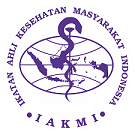The Tradition of “Basunat” (Genital Circumcision) in Female Children and Its Implication on Reproductive Health
DOI:
https://doi.org/10.26911/thejhpb.2025.10.03.04Abstract
Background: The tradition of basunat or circumsised on baby girls is still carried out by the Banjaresse in South Kalimantan as part of a cultural heritage that is believed to be related to purity, family honor, and a smooth delivery process. Although it has no medical basis and is prohibited by law, this practice is still preserved on the basis of social, cultural, and religious values that develop in the community. This study aims to examine the form of basunat implementation on baby girls in the Banjar community and evaluate its impact on reproductive health.
Subjects and Method: This was a qualitative study with a descriptive-exploratory approach. The study was conducted in Tapin, Barito Kuala, Banjarmasin, and Banjar Districts of South Kalimantan, Indonesia. The informants were village shamans, midwives, indigenous people, and women who had been circumcised. Data were collected through documentation and in-depth interviews, then analyzed using data reduction techniques, narrative presentation, and drawing conclusions.
Results: The study showed that the practice of circumcision is still commonly carried out symbolically and physically, generally by village shamans with traditional tools that are not sterile. The community still believes that circumcision can smooth the delivery process and is a cultural or religious obligation. However, this practice has the potential to have negative impacts on women's physical and psychological health
Conclusion: Policy interventions that prioritize local culture-based education and the involvement of religious and community leaders are needed. This approach can help change public perception and support the sustainable elimination of this tradition.
Keywords:
tradition, circumcision , female genital, reproductive healthHow to Cite
References
Abdulcadir J, Say L, Pallitto C (2017). What do we know about assessing health-care students and professionals’ knowledge, attitude and practice regarding female genital mutilation? A systematic review. Reprod Health. 14:1–13.
Ahlian A, Muawanah S (2019). Tradisi, praktik khitan anak perempuan dan tinjauan aspek medis di pesisir Pantai Selatan Jawa Tengah. J Ilmu Kebidanan Kesehatan. 10(2).
Aminah S, Utari AP, Maisyarah S (2022). Women and sexual violence: A study of khitan tradition in West Nusa Tenggara. 2nd World Conf Gender Stud (WCGS 2021). 166–175.
Ananda ZN (2024). Analisis khitan pada bayi perempuan di wilayah kerja Puskesmas Jakamulya Kabupaten Bekasi Selatan [Undergraduate the-sis]. Jakarta: Universitas Nasional.
Berg RC, Underland V (2014). Gynecolo-gical consequences of female genital mutilation/cutting (FGM/C). Oslo: Nasjonalt kunnskapssenter for helsetjenesten.
Bonavina G, Kaltoud R, Ruffolo AF, Can-diani M, Salvatore S (2022). Female genital mutilation and cutting and obstetric outcomes. Obstet Gynecol. 140(1):87–90. doi:10.1097/AOG.00-00000000004830.
Fatimah, Massi MN, Febriani ADB, Hatta M, Permatasari TAE, Hidayati E, Hamidah, Khumaidi MA, Akaputra R, Turrahmi H, Anggraini RP (2021). Effect of breastfeeding on children’s health and its relationship to NRAMP1 expression: A cross-sectional study. Ann Med Surg (Lond). 71:103017. doi:10.1016/j.amsu.2021.103017.
Galgano AC, Kikuchi JY (2025). Female genital mutilation or cutting. [Publi-cation type not specified].
Hidayati S, Kurniasari ND, Rahmawati Y (2017). Motif dan persepsi sunat perempuan di Madura. J Komunikasi. 11(2):159–163.
Jaya VAFT, Kim Y, Kang M. (2024). Cutting through complexity: An intersectional analysis of female genital cutting in Indonesia. Womens Stud Int Forum. 104:102906. doi:10.1016/j.wsif.2024.-102906.
Khosla R, Banerjee J, Chou D, Say L, Fried ST. (2017). Gender equality and human rights approaches to female genital mutilation: a review of inter-national human rights norms and standards. Reprod Health. 14(1):59. doi:10.1186/s12978-017-0322-5.
Kimani S, Barrett H, Muteshi-Stranchan J. (2023). Medicalisation of female genital mutilation is a dangerous development. BMJ. 380:302. doi:1-0.1136/bmj.p302.
Köbach A, Ruf-Leuschner M, Elbert T. (2018). Psychopathological sequelae of female genital mutilation and their neuroendocrinological associations. BMC Psychiatry. 18(1):187. doi:10.11-86/s12888-018-1757-0.
Kurniati F, Fujiana F, Hayati UF. (2022). Kajian literatur: Sunat perempuan ditinjau dari aspek umum dan kese-hatan. Al-Asalmiya Nurs. 11(1).
Lancet T. (2024). Medicalised female genital mutilation must stop. Lancet. 404(10451):405. doi:10.1016/S0140-6736(24)01592-7.
Leye E, Van Eekert N, Shamu S, Esho T, Barrett H. (2019). Debating medica-lization of female genital mutilati-on/cutting (FGM/C): learning from (policy) experiences across countries. Reprod Health. 16(1):158. doi:10.11-86/s12978-019-0817-3.
Momoh C (2017). Female genital mutila-tion. In: The social context of birth. Routledge. p.125–140.
Pérez-López FR, Ornat L, López-Baena MT, Pérez-Roncero GR, Tajada-Duaso MC, Chedrau P. (2020). Association of female genital mutilation and female sexual dysfunction: A systematic review and meta-analysis. Eur J Obstet Gynecol Reprod Biol. 254: 236–244. doi:10.1016/j.ejogrb.2020.-09.031.
Reman T, Balligand V, Schoefs B, Feipel V, Bertuit J (2023). Psychological conse-quences of female genital mutilation: A mixed-method systematic review. S Afr J Physiother. 79(1):1877. doi:10.-4102/sajp.v79i1.1877.
Sarayloo K, Latifnejad Roudsari R, Elhadi A. (2019). Health consequences of the female genital mutilation: A sys-tematic review. Galen Med J. 8:e1336. doi:10.22086/gmj.v8i0.1336.
Smith H, Stein K. (2017). Psychological and counselling interventions for female genital mutilation. Int J Gynaecol Obstet. 136:60–64. doi:10.1002/ijgo.-12051.
Young J, Nour NM, Macauley RC, Narang SK, Johnson-Agbakwu C, Suchdev P, Chan KJ, Howard CR, McGann P, St Clair NE (2020). Diagnosis, mana-gement, and treatment of female genital mutilation or cutting in girls. Pediatrics. 146(2).
Zurynski Y, Sureshkumar P, Phu A, Elliott E. (2015). Female genital mutilation and cutting: a systematic literature review of health professionals’ know-ledge, attitudes and clinical practice. BMC Int Health Hum Rights. 15:1–18.



